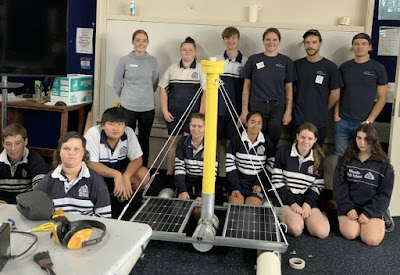STEM (Science, Technology, Engineering and Maths) education centres around student learning in an interdisciplinary and applied approach. What separates STEM learning from the traditional discrete subject approach, is the blended learning environment where students use critical thinking focusing on the real-world applications of problem solving. This kind of authenticity builds engagement and empathy where students can see the genuine impact of their learning.
Innovative STEM learning in schools is crucial and will play a pivotal role in building a robust future economy. We are in a time currently known as the fourth industrial revolution. It is characterized by a fusion of technologies that is blurring the lines between the physical, digital, and biological spheres. Businesses competing in the global economy driven by data, digital technologies and innovation will need more employees trained in STEM, with research indicating 75% of the fastest growing occupations now require these skills. Further modelling suggests that if we shift just 1% of the workforce into STEM roles we would add $57.4 billion to
GDP over 20 years.
However, there is mounting evidence which indicates our education systems are not up to the challenge. Recent results on international assessments have shown a continuing decline in performance by Australian students and a lack of teachers who are qualified to teach STEM subjects. While the curriculum is being modified to address changes in STEM learning, there are concerns that the Australian curriculum is not future-facing and lacking in it's interdisciplinary approach.
AusOcean's student-led citizen science program Network Blue is one school STEM program which focuses on tackling real world ocean science and technology challenges. A key component of Network Blue involves the construction, deployment and maintenance of an AusOcean "rig"; a low-cost research buoy for supporting ocean science in coastal waters. There are a plethora of opportunities that expose students to different aspects of the STEM curriculum. Everything from construction, deployment and monitoring of their rig is undertaken by students. This includes electronic assembly, hardware and software testing, and data collection and analysis. Students can also design and build their own "payload experiments" which are housed inside the rig's mast and explore other research avenues depending on their interests. Non-technical learning opportunities range from outdoor education, water sports, community engagement, collaborating with and recruiting other schools, fundraising, entrepreneurship, and more. Schools are encouraged to establish partnerships with community groups and local NFPs who provide real-world context while boosting student community involvement.
Having successfully rolled out the program across metropolitan Adelaide, Network Blue is expanding regionally, with Whyalla High School the first to join from the Eyre Peninsula. AusOcean is aware that students in regional areas are at a major disadvantage when it comes to STEM opportunities, a situation that in turn limits their ability to gain entry to university study or pursue STEM career pathways. Therefore, focusing on regional and lower socioeconomic schools will continue to be a priority.
AusOcean with Whyalla High School students and their completed rig.
Increasing community connections will play a key role in improving student and teacher STEM engagement as outlined in Challenges in STEM Learning in Australian Schools Literature and Policy Review. This review notes that programs that focus on engagement with ‘real-world’ problem solving can contribute to increased levels of motivation through informal learning opportunities. We need more programs that promote connections with industry, research institutions and community groups to reinvigorate student learning pathways. Integrated approaches are needed to create connections between school STEM projects and relevant real-world contexts in which skills can be developed. Creating a workforce fit for the future is integral if we are to realise our potential for innovation.
To learn more about AusOcean's student-led citizen science program head to https://www.ausocean.org/projects.
AusOcean is a not-for-profit ocean research organisation that supports open source practices. Open source approaches to tackling environmental issues means embracing collaborative tools and workflows which enables processes and progress to be fully transparent. A critical aspect of working open is sharing data not only with your immediate team but with others across the world who can learn, adapt and contribute to collective research. By contributing to, and supporting open practices within the scientific community, we can accelerate research and encourage transparency. All tech assembly guides can be found at https://www.ausocean.org/technology



Comments
Post a Comment